Do you have a question about the Weil-McLain Evergreen 299 and is the answer not in the manual?
Manual must be used by qualified installer/technician. Failure to comply can cause injury or death.
Control can operate single or multiple boilers, coordinating heating circuits and priority levels.
Wizard guides through step-by-step setup for chosen application. Context-sensitive help available.
Defines terms like DANGER, WARNING, CAUTION, NOTICE for risk communication.
Specific requirements for installations within the Commonwealth of Massachusetts.
Guidelines for boiler placement, foundation, and clearance from combustibles.
Special precautions for installing boilers in residential garages.
Details on requirements for the special pressurized venting system.
Ensuring proper flooring and foundation for boiler installation.
Instructions and requirements for wall-mounting the boiler using a kit.
Steps for installing necessary fittings for hydrostatic testing.
Procedure for filling the boiler and system with water and performing the test.
Instructions for converting the boiler for propane operation, including venturi.
Details on operating the boiler with propane and verifying venturi installation.
Guidelines for sizing natural gas piping based on input and length.
Guidelines for sizing propane gas piping based on supply pressure.
Hazards associated with contaminated combustion air and its sources.
Procedure to test the common vent system after removing an old boiler.
Requirements for sidewall horizontally-vented equipment in MA.
Manufacturer's responsibility for providing venting instructions and parts.
Specifies minimum distances for vent terminations from walkways and buildings.
Locations where vent terminations are not permitted due to potential hazards.
Specifies air opening sizes when other appliances are in the room.
Specifies air opening sizes when no other appliances are in the room.
Details special exceptions for air openings in large spaces.
Step-by-step instructions for installing sidewall vent with separate pipes.
Lists approved materials and maximum lengths for vent and air piping.
Guidelines for selecting the proper location for sidewall terminations.
Step-by-step instructions for installing W-M sidewall vent/air plate.
Guidelines for selecting the proper location for sidewall terminations.
Step-by-step instructions for concentric horizontal sidewall termination.
Guidelines for selecting the proper location for sidewall terminations.
Step-by-step instructions for vertical vent and sidewall air termination.
Procedures for preparing roof penetrations for vent and air piping.
Step-by-step instructions for concentric vertical termination.
Guidelines for selecting the proper location for vertical terminations.
Instructions for assembling the concentric termination kit.
Step-by-step instructions for vertical vent and sidewall air termination.
Procedure for preparing the vent pipe penetration through walls/floors.
Guidance on installing vent and air piping from boiler to termination.
Recommendations for sizing the boiler loop piping for space heating.
General guidelines and considerations for system piping.
Method for selecting pipe sizes and circulators based on circuit load.
Considerations for connecting to heating coils in air handling units.
Piping suggestions for diaphragm or bladder-type expansion tanks.
Piping suggestions for closed-type expansion tanks.
Configuration for zone valve systems with primary/secondary boiler loop.
Connecting a DHW tank as a zone or direct connection.
How the control manages boiler and system circulators.
Requirement for a system expansion tank when connecting DHW.
How the control manages circulators for DHW priority operation.
Requirement for a supplementary expansion tank for chiller systems.
Connecting a DHW tank for chiller systems.
Managing circulators in systems with water chillers.
Steps for preparing PVC fittings and gasket for condensate line.
Instructions for connecting the condensate trap line.
Steps for connecting the gas supply piping to the boiler.
Procedures for checking gas connections for leaks and safety.
Guidelines for routing and sealing wires into the control cabinet.
Essential wiring connections for boiler operation.
Wiring for additional system components like sensors and limits.
Details on providing and sizing the 120 VAC power supply.
Information on using the 120VAC outputs for circulators or other devices.
Wiring instructions for connecting the boiler circulator.
Wiring for thermostats, aquastats, and other system inputs.
Instructions for installing the outdoor temperature sensor.
Wiring for optional external limit controls.
Wiring instructions for the low water cutoff device.
Connecting terminals for remote alarm notification.
Wiring for activating other heat sources.
Connecting a remote analog input to regulate supply temperature.
Suggested applications for zoning with circulators.
Suggested applications for zoning with zone valves.
Steps for setting up the Evergreen control using WIZARD or manual entry.
Highlights key features like priority levels, display, and outputs.
Summary of the boiler's operating sequence based on control display statuses.
Steps for initial boiler setup and accessing contractor menus.
Guides through step-by-step setup for chosen application.
Using a remote analog input to regulate supply temperature.
Using 0-10VDC input for remote boiler modulation.
Explains display colors and what they indicate during operation.
Details on navigating the status screen and available information.
Setup for multi-zone heating with circulators and DHW.
Required and optional settings for Express Setup Example A.
Setup for 2- or 3-zone heating with circulators and DHW.
Required and optional settings for Express Setup Example B.
Setup for multi-zone heating with zone valves and DHW.
Required and optional settings for zone valve setups.
Lists system types and their default factory settings.
Overview of menu navigation for contractor settings.
Setting the user mode to BASIC or ADVANCED.
Accessing and adjusting boiler model, altitude, and sensor settings.
Details on available settings like LP Gas, WWSD Temp, and Freeze Protect.
Lists inputs assigned to each priority level.
Choosing system type (e.g., FAN-COIL, RADIANT) for each priority.
Explains priority levels and input/output assignments.
Steps to assign system type and priority to inputs.
Displays current temperatures for boiler sensors and system.
Shows status of boiler inputs like thermostats and sensors.
Displays status of boiler outputs like circulators and gas valve.
Shows burner runtime, rotation time, and ignition counts.
View historical fault data, lockout history, and error details.
Allows manual control of boiler functions for testing and diagnostics.
Enter contractor details, installation date, and maintenance reminders.
Set current date and time for accurate logging and reminders.
List of essential tools needed for initial boiler start-up.
Procedure for flushing the system to remove sediment before filling.
Ensuring proper water pH, chloride, and inhibitor levels for boiler longevity.
Verify thermostat wiring and voltage for proper operation.
Inspecting and filling the condensate trap and lines.
Safety procedure for detecting gas leaks before and during operation.
Checklist of critical items before initiating boiler start-up.
Ensuring the boiler is correctly converted for propane firing.
Warning against adjusting or measuring gas valve outlet pressure.
Adjusting throttle screw for optimal CO2 at high fire.
Adjusting offset screw for optimal CO2 at low fire.
Setting and verifying operation of boiler control functions.
Checklist of completed installation and setup tasks.
Final steps including filling out the installation certificate.
Provides schedules for annual service technician and owner maintenance.
Essential checks and part replacements for the first year of operation.
Guidelines for safe handling of ceramic fiber materials.
Procedure for inspecting all water, gas, vent, and air piping for leaks.
Verifying expansion tank type, size, and waterlogging.
Procedure for inspecting and cleaning the ignition electrode assembly.
Procedure for inspecting and cleaning the flame sense rod assembly.
Steps for removing, cleaning, and inspecting the burner.
Visual inspection of the heat exchanger interior and refractory condition.
Procedure for checking burner flame quality and signal strength.
Verifying blower speeds against specifications for proper operation.
Instructions for operating a single boiler in manual test mode.
Procedure for inspecting and verifying the boiler relief valve.
Steps to ensure proper operation after maintenance or servicing.
List of tools and kits necessary for troubleshooting tasks.
Methods for testing temperature sensors for proper resistance.
Understanding control display behavior during faults and reset methods.
Guidance on interpreting the last three lockout history records.
Procedure for clearing all lockout histories from the control.
Troubleshooting steps when the display is blank or non-responsive.
Diagnosing and resolving rapid temperature rise issues.
Troubleshooting low water cutoff errors.
Diagnosing and resolving high supply water temperature issues.
Addressing errors related to open limit switches.
Troubleshooting gas valve errors and lockouts.
Diagnosing and resolving ignition failure errors.
Troubleshooting issues with the outdoor temperature sensor.
Routine tasks for maintaining the boiler system.
Procedure for cleaning the heat exchanger's water side.
Safety steps before servicing and reinstalling the boiler door.
List of tools needed for cleaning the heat exchanger flue side.
Procedure for removing and inspecting the igniter assembly.
Visual inspection of the combustion chamber and refractory condition.
Steps to remove parts for accessing the heat exchanger's flue side.
Procedure for removing the refractory and replacing the burner gasket.
Steps for reinstalling the heat exchanger cover plate and refractory.
Instructions for reinstalling the burner, igniter, and flame sense rod.
Guidance on ordering genuine Weil-McLain replacement parts.
Safety precautions for handling ceramic fiber materials.
Details on various vent and air piping kits available.
List and description of front door and gasket kit parts.
List of parts for the Evergreen 220 heat exchanger assembly.
List of parts for Evergreen 299/300/399 heat exchanger assembly.
Parts related to the gas valve and venturi assembly.
Parts for the blower and inlet air silencer assembly.
List of temperature sensors and the transformer part numbers.
Part numbers for the control module and circuit boards.
Provides overall dimensions for Evergreen 220/299/300/399 models.
Performance ratings certified by AHRI for Evergreen boilers.
DOE efficiency and capacity ratings, including derates.
Performance data for multiple Evergreen boiler installations.
Installer must certify that instructions were followed and system is correct.
Fields for recording boiler settings and parameters.
Fields for recording priority settings for system operation.
Recording settings for priority levels 2, 3, and 4.
Manual must be used by qualified installer/technician. Failure to comply can cause injury or death.
Control can operate single or multiple boilers, coordinating heating circuits and priority levels.
Wizard guides through step-by-step setup for chosen application. Context-sensitive help available.
Defines terms like DANGER, WARNING, CAUTION, NOTICE for risk communication.
Specific requirements for installations within the Commonwealth of Massachusetts.
Guidelines for boiler placement, foundation, and clearance from combustibles.
Special precautions for installing boilers in residential garages.
Details on requirements for the special pressurized venting system.
Ensuring proper flooring and foundation for boiler installation.
Instructions and requirements for wall-mounting the boiler using a kit.
Steps for installing necessary fittings for hydrostatic testing.
Procedure for filling the boiler and system with water and performing the test.
Instructions for converting the boiler for propane operation, including venturi.
Details on operating the boiler with propane and verifying venturi installation.
Guidelines for sizing natural gas piping based on input and length.
Guidelines for sizing propane gas piping based on supply pressure.
Hazards associated with contaminated combustion air and its sources.
Procedure to test the common vent system after removing an old boiler.
Requirements for sidewall horizontally-vented equipment in MA.
Manufacturer's responsibility for providing venting instructions and parts.
Specifies minimum distances for vent terminations from walkways and buildings.
Locations where vent terminations are not permitted due to potential hazards.
Specifies air opening sizes when other appliances are in the room.
Specifies air opening sizes when no other appliances are in the room.
Details special exceptions for air openings in large spaces.
Step-by-step instructions for installing sidewall vent with separate pipes.
Lists approved materials and maximum lengths for vent and air piping.
Guidelines for selecting the proper location for sidewall terminations.
Step-by-step instructions for installing W-M sidewall vent/air plate.
Guidelines for selecting the proper location for sidewall terminations.
Step-by-step instructions for concentric horizontal sidewall termination.
Guidelines for selecting the proper location for sidewall terminations.
Step-by-step instructions for vertical vent and sidewall air termination.
Procedures for preparing roof penetrations for vent and air piping.
Step-by-step instructions for concentric vertical termination.
Guidelines for selecting the proper location for vertical terminations.
Instructions for assembling the concentric termination kit.
Step-by-step instructions for vertical vent and sidewall air termination.
Procedure for preparing the vent pipe penetration through walls/floors.
Guidance on installing vent and air piping from boiler to termination.
Recommendations for sizing the boiler loop piping for space heating.
General guidelines and considerations for system piping.
Method for selecting pipe sizes and circulators based on circuit load.
Considerations for connecting to heating coils in air handling units.
Piping suggestions for diaphragm or bladder-type expansion tanks.
Piping suggestions for closed-type expansion tanks.
Configuration for zone valve systems with primary/secondary boiler loop.
Connecting a DHW tank as a zone or direct connection.
How the control manages boiler and system circulators.
Requirement for a system expansion tank when connecting DHW.
How the control manages circulators for DHW priority operation.
Requirement for a supplementary expansion tank for chiller systems.
Connecting a DHW tank for chiller systems.
Managing circulators in systems with water chillers.
Steps for preparing PVC fittings and gasket for condensate line.
Instructions for connecting the condensate trap line.
Steps for connecting the gas supply piping to the boiler.
Procedures for checking gas connections for leaks and safety.
Guidelines for routing and sealing wires into the control cabinet.
Essential wiring connections for boiler operation.
Wiring for additional system components like sensors and limits.
Details on providing and sizing the 120 VAC power supply.
Information on using the 120VAC outputs for circulators or other devices.
Wiring instructions for connecting the boiler circulator.
Wiring for thermostats, aquastats, and other system inputs.
Instructions for installing the outdoor temperature sensor.
Wiring for optional external limit controls.
Wiring instructions for the low water cutoff device.
Connecting terminals for remote alarm notification.
Wiring for activating other heat sources.
Connecting a remote analog input to regulate supply temperature.
Suggested applications for zoning with circulators.
Suggested applications for zoning with zone valves.
Steps for setting up the Evergreen control using WIZARD or manual entry.
Highlights key features like priority levels, display, and outputs.
Summary of the boiler's operating sequence based on control display statuses.
Steps for initial boiler setup and accessing contractor menus.
Guides through step-by-step setup for chosen application.
Using a remote analog input to regulate supply temperature.
Using 0-10VDC input for remote boiler modulation.
Explains display colors and what they indicate during operation.
Details on navigating the status screen and available information.
Setup for multi-zone heating with circulators and DHW.
Required and optional settings for Express Setup Example A.
Setup for 2- or 3-zone heating with circulators and DHW.
Required and optional settings for Express Setup Example B.
Setup for multi-zone heating with zone valves and DHW.
Required and optional settings for zone valve setups.
Lists system types and their default factory settings.
Overview of menu navigation for contractor settings.
Setting the user mode to BASIC or ADVANCED.
Accessing and adjusting boiler model, altitude, and sensor settings.
Details on available settings like LP Gas, WWSD Temp, and Freeze Protect.
Lists inputs assigned to each priority level.
Choosing system type (e.g., FAN-COIL, RADIANT) for each priority.
Explains priority levels and input/output assignments.
Steps to assign system type and priority to inputs.
Displays current temperatures for boiler sensors and system.
Shows status of boiler inputs like thermostats and sensors.
Displays status of boiler outputs like circulators and gas valve.
Shows burner runtime, rotation time, and ignition counts.
View historical fault data, lockout history, and error details.
Allows manual control of boiler functions for testing and diagnostics.
Enter contractor details, installation date, and maintenance reminders.
Set current date and time for accurate logging and reminders.
List of essential tools needed for initial boiler start-up.
Procedure for flushing the system to remove sediment before filling.
Ensuring proper water pH, chloride, and inhibitor levels for boiler longevity.
Verify thermostat wiring and voltage for proper operation.
Inspecting and filling the condensate trap and lines.
Safety procedure for detecting gas leaks before and during operation.
Checklist of critical items before initiating boiler start-up.
Ensuring the boiler is correctly converted for propane firing.
Warning against adjusting or measuring gas valve outlet pressure.
Adjusting throttle screw for optimal CO2 at high fire.
Adjusting offset screw for optimal CO2 at low fire.
Setting and verifying operation of boiler control functions.
Checklist of completed installation and setup tasks.
Final steps including filling out the installation certificate.
Provides schedules for annual service technician and owner maintenance.
Essential checks and part replacements for the first year of operation.
Guidelines for safe handling of ceramic fiber materials.
Procedure for inspecting all water, gas, vent, and air piping for leaks.
Verifying expansion tank type, size, and waterlogging.
Procedure for inspecting and cleaning the ignition electrode assembly.
Procedure for inspecting and cleaning the flame sense rod assembly.
Steps for removing, cleaning, and inspecting the burner.
Visual inspection of the heat exchanger interior and refractory condition.
Procedure for checking burner flame quality and signal strength.
Verifying blower speeds against specifications for proper operation.
Instructions for operating a single boiler in manual test mode.
Procedure for inspecting and verifying the boiler relief valve.
Steps to ensure proper operation after maintenance or servicing.
List of tools and kits necessary for troubleshooting tasks.
Methods for testing temperature sensors for proper resistance.
Understanding control display behavior during faults and reset methods.
Guidance on interpreting the last three lockout history records.
Procedure for clearing all lockout histories from the control.
Troubleshooting steps when the display is blank or non-responsive.
Diagnosing and resolving rapid temperature rise issues.
Troubleshooting low water cutoff errors.
Diagnosing and resolving high supply water temperature issues.
Addressing errors related to open limit switches.
Troubleshooting gas valve errors and lockouts.
Diagnosing and resolving ignition failure errors.
Troubleshooting issues with the outdoor temperature sensor.
Routine tasks for maintaining the boiler system.
Procedure for cleaning the heat exchanger's water side.
Safety steps before servicing and reinstalling the boiler door.
List of tools needed for cleaning the heat exchanger flue side.
Procedure for removing and inspecting the igniter assembly.
Visual inspection of the combustion chamber and refractory condition.
Steps to remove parts for accessing the heat exchanger's flue side.
Procedure for removing the refractory and replacing the burner gasket.
Steps for reinstalling the heat exchanger cover plate and refractory.
Instructions for reinstalling the burner, igniter, and flame sense rod.
Guidance on ordering genuine Weil-McLain replacement parts.
Safety precautions for handling ceramic fiber materials.
Details on various vent and air piping kits available.
List and description of front door and gasket kit parts.
List of parts for the Evergreen 220 heat exchanger assembly.
List of parts for Evergreen 299/300/399 heat exchanger assembly.
Parts related to the gas valve and venturi assembly.
Parts for the blower and inlet air silencer assembly.
List of temperature sensors and the transformer part numbers.
Part numbers for the control module and circuit boards.
Provides overall dimensions for Evergreen 220/299/300/399 models.
Performance ratings certified by AHRI for Evergreen boilers.
DOE efficiency and capacity ratings, including derates.
Performance data for multiple Evergreen boiler installations.
Installer must certify that instructions were followed and system is correct.
Fields for recording boiler settings and parameters.
Fields for recording priority settings for system operation.
Recording settings for priority levels 2, 3, and 4.
| Model | Evergreen 299 |
|---|---|
| Fuel Type | Natural Gas or Propane |
| Input BTU/hr | 299, 000 |
| Output BTU/hr | 285, 000 |
| Vent Type | Direct Vent |
| Modulation Ratio | 5:1 |
| Heat Exchanger Material | Stainless Steel |
| Ignition Type | Electronic Ignition |
| Type | Gas Boiler |
| Efficiency | 95% |
| Dimensions | See specific model data |
| Weight | See specific model data |
| Venting | PVC or CPVC |
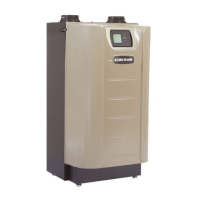
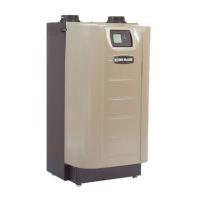
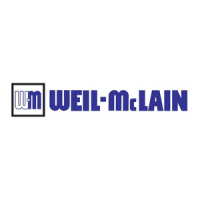

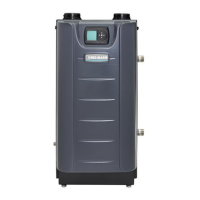
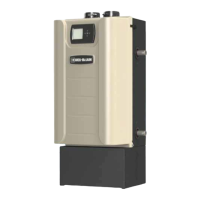



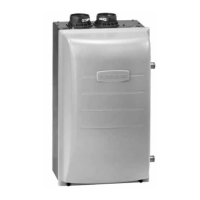

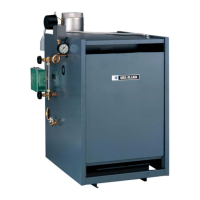
